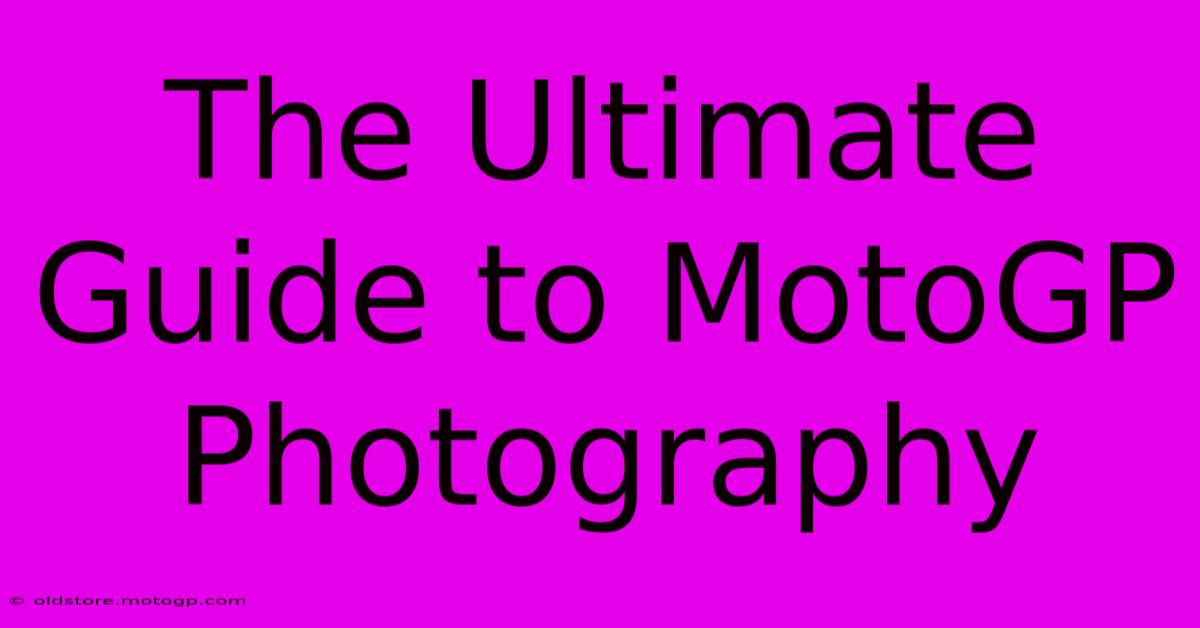The Ultimate Guide To MotoGP Photography

Table of Contents
The Ultimate Guide to MotoGP Photography: Capture the Speed and Thrills
MotoGP. The roar of the engines, the blur of speed, the breathtaking skill of the riders – it's a spectacle that demands to be captured. This ultimate guide will equip you with the knowledge and techniques to take stunning MotoGP photographs, whether you're a seasoned pro or just starting out.
Gear Up for the Grand Prix: Essential Equipment
Before you even think about pointing your camera, you need the right tools. MotoGP photography requires gear that can handle the speed, the distance, and the challenging lighting conditions.
1. Camera Body: Speed is Key
You'll need a camera body that can shoot fast. A DSLR or mirrorless camera with a high frame rate (at least 7fps, ideally much higher) is crucial to freeze the action. Consider models with robust autofocus systems capable of tracking fast-moving subjects.
2. Lenses: Reach for the Stars (and the Track)
- Telephoto Lenses: These are your bread and butter. A long telephoto lens, such as a 100-400mm or even a 600mm or longer, is essential to capture the detail of the bikes and riders from the grandstands or press areas.
- Wide-Angle Lenses: For capturing the overall atmosphere of the race, including the crowds and the surrounding environment, a wide-angle lens is invaluable.
3. Accessories: Protecting Your Investment
- Fast Memory Cards: Use high-speed memory cards with ample storage capacity to avoid missed shots. Consider using multiple cards to prevent running out of space during the race.
- Extra Batteries: MotoGP events can be long, and your camera battery will drain quickly. Carry several fully charged batteries.
- Monopod or Tripod: A monopod offers stability for long telephoto lenses, while a tripod is helpful for capturing wider shots or during slower moments. Remember to choose a lightweight and sturdy option.
Mastering the Techniques: From Settings to Composition
Getting the perfect MotoGP shot involves more than just pointing and shooting. Master these techniques for stunning results.
1. Shutter Speed: Freezing the Action
A fast shutter speed is paramount. You'll need at least 1/1000th of a second, and even faster for sharp images of bikes at top speed. Experiment to find the sweet spot that balances sharpness with sufficient light.
2. Aperture: Controlling Depth of Field
Use a relatively narrow aperture (high f-stop, like f/8 or f/11) to keep both the rider and the bike in sharp focus. However, be mindful that this will reduce the amount of light entering the lens.
3. ISO: Balancing Light and Noise
Adjust your ISO setting according to the lighting conditions. While you want to keep ISO as low as possible to minimize noise, you may need to increase it in low-light situations. Modern cameras handle higher ISO values well, so don't be afraid to experiment.
4. Composition: Framing the Shot
- Leading Lines: Utilize the track itself or other elements to lead the viewer's eye to the subject.
- Rule of Thirds: Position the rider and bike off-center to create a more dynamic composition.
- Background: Be mindful of the background; a cluttered background can distract from the main subject.
Beyond the Basics: Advanced Techniques for MotoGP Photography
To elevate your MotoGP photography, consider these advanced techniques:
- Panning: Follow the bike with your camera as it moves, creating a blurred background that emphasizes the speed of the action. This technique requires practice.
- Burst Mode: Capture a rapid sequence of shots to increase your chances of getting that perfect moment.
- Pre-focusing: Anticipate where the riders will be and pre-focus your lens to ensure you don't miss the shot.
Post-Processing: Enhancing Your Masterpieces
Even the best shots can benefit from post-processing. Use software like Adobe Lightroom or Photoshop to:
- Adjust Exposure and Contrast: Fine-tune the brightness and contrast of your images.
- Sharpening: Enhance the detail and sharpness of the images, particularly important for fast-action shots.
- Cropping and Composition: Refine your composition by cropping out unwanted elements.
Ethical Considerations in MotoGP Photography
Respect the event organizers, other photographers, and most importantly, the safety of the riders. Follow all rules and regulations, and never endanger yourself or others to get a shot.
By mastering these techniques and utilizing the right equipment, you'll be well on your way to capturing breathtaking MotoGP photographs that truly capture the speed, excitement, and skill of this thrilling sport. Remember to practice, experiment, and most importantly, have fun!

Thank you for visiting our website wich cover about The Ultimate Guide To MotoGP Photography. We hope the information provided has been useful to you. Feel free to contact us if you have any questions or need further assistance. See you next time and dont miss to bookmark.
Featured Posts
-
Racing Motorcycles Beyond Limits
Feb 24, 2025
-
Invest In Your Legacy With Cota Lot A
Feb 24, 2025
-
F1 Starting Grid Tomorrows Line Up Revealed
Feb 24, 2025
-
Choosing The Right Yamaha V4 For Your Boat
Feb 24, 2025
-
Austin Grand Prix Parking Your One Stop Shop For Parking
Feb 24, 2025
